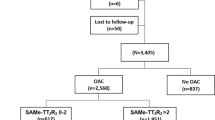Abstract
Stroke prevention, achieved with oral anticoagulation therapy (OAT), is central to the management of patients with atrial fibrillation (AF). Well-managed OAT, as reflected by a long time in therapeutic range (TTR), is associated with good clinical outcomes. The SAME-TT2R2 score has been proposed to identify patients who will maintain a high average TTR on vitamin K antagonists (VKA) treatment. The objective of the study was to validate this score in a cohort of AF patients followed by an anticoagulation clinic. We applied the SAME-TT2R2 score to 1,089 patients with AF on VKAs followed by two anticoagulation clinics. The median TTR overall for the whole cohort was 73.0 %. There was a significant decline in mean (or median) TTR in relation to the SAME-TT2R2 score (p = 0.042). When the SAME-TT2R2 scores were categorized we find a TTR 74.0 % for score ≤2 and 68.0 % for score >2 (p = 0.006). The rate of major bleeding events and stroke/TIA was 1.78 × 100 patient-years (pt-yrs) and 1.26 × 100 pt-yrs, respectively. No relationship exists between the SAME-TT2R2 score and adverse events. We describe the first validation of the SAME-TT2R2 score in AF patients where, despite an overall good quality of anticoagulation, the SAME-TT2R2 score is able to identify the patients who are less likely to do well on VKA therapy if this is the chosen OAT.
Similar content being viewed by others
References
Camm AJ, Lip GY, De Caterina R, Savelieva I, Atar D, Hohnloser SH, Hindricks G, Kirchhof P; ESC Committee for Practice Guidelines (CPG) (2012) Focused update of the ESC Guidelines for the management of atrial fibrillation: an update of the 2010 ESC Guidelines for the management of atrial fibrillation. Developed with the special contribution of the European Heart Rhythm Association. Eur Heart J 33:2719–2747
Poli D, Lip GY, Antonucci E, Grifoni E, Lane D (2011) Stroke risk stratification in a “real-world” elderly anticoagulated atrial fibrillation population. J Cardiovasc Electrophysiol 2:25–30
Prisco D, Cenci C, Silvestri E, Emmi G, Barnini T, Tamburini C (2012) The risk stratification in atrial fibrillation. Intern Emerg Med S3:S233–S240
De Caterina R, Husted S, Wallentin L, Andreotti F, Arnesen H, Bachmann F, Baigent C, Huber K, Jespersen J, Kristensen SD, Lip GY, Morais J, Rasmussen LH, Siegbahn A, Verheugt FW, Weitz JI (2013) General mechanisms of coagulation and targets of anticoagulants (section I): position paper of the ESC Working Group on Thrombosis-Task Force on Anticoagulants in Heart Disease. Thromb Haemost 109:569–579
Gallagher AM, Setakis E, Plumb JM, Clemens A, van Staa TP (2011) Risks of stroke and mortality associated with suboptimal anticoagulation in atrial fibrillation patients. Thromb Haemost 106:968–977
Wan Y, Heneghan C, Perera R, Roberts N, Hollowell J, Glasziou P, Bankhead C, Xu Y (2008) Anticoagulation control and prediction of adverse events in patients with atrial fibrillation: a systematic review. Circ Cardiovasc Qual Outcomes 1:84–91
Oake N, Jennings A, Forster AJ, Fergusson D, Doucette S, van Walraven C (2008) Anticoagulation intensity and outcomes among patients prescribed oral anticoagulant therapy: a systematic review and meta-analysis. CMAJ 179:235–244
Connolly SJ, Pogue J, Eikelboom J, Flaker G, Commerford P, Franzosi MG, Healey JS, Yusuf S (2008) Benefit of oral anticoagulant over antiplatelet therapy in atrial fibrillation depends on the quality of international normalized ratio control achieved by centers and countries as measured by time in therapeutic range. Circulation 118:2029–2037
Wallentin L, Yusuf S, Ezekowitz MD, Alings M, Flather M, Franzosi MG, Pais P, Dans A, Eikelboom J, Oldgren J, Pogue J, Reilly PA, Yang S, Connolly SJ; RE-LY investigators (2010) Efficacy and safety of dabigatran compared with warfarin at different levels of international normalised ratio control for stroke prevention in atrial fibrillation: an analysis of the RE-LY trial. Lancet 376:975–983
Wallentin L, Lopes RD, Hanna M, Thomas L, Hellkamp A, Nepal S, Hylek EM, Al-Khatib SM, Alexander JH, Alings M, Amerena J, Ansell J, Aylward P, Bartunek J, Commerford P, De Caterina R, Erol C, Harjola VP, Held C, Horowitz JD, Huber K, Husted S, Keltai M, Lanas F, Lisheng L, McMurray JJV, Oh BH, Rosenqvist M, Ruzyllo W, Steg PG, Vinereanu D, Xavier D, Granger CB; on behalf of the Apixaban for Reduction in Stroke and Other Thromboembolic Events in Atrial Fibrillation (ARISTOTLE) Investigators (2013) Efficacy and safety of apixaban compared with warfarin at different levels of predicted international normalized ratio control for stroke prevention in atrial fibrillation. Circulation 127:2166–2176
Apostolakis S, Sullivan RM, Olshansky B, Lip GY (2013) Factors affecting quality of anticoagulation control amongst atrial fibrillation patients on warfarin: the SAME-TT2R2 (sex female, age less than 60, medical history, treatment strategy (rhythm control), tobacco use (doubled), race (doubled) score. Chest 144:1555–1563
Rosendaal FR, Cannegieter SC, van der Meer FJM, Briet E (1993) A method to determine the optimal intensity of oral anticoagulant therapy. Thromb Haemost 69:236–239
Ageno W, Gallus AS, Wittkowsky A, Crowther M, Hylek EM, Palareti G; American College of Chest Physicians (2012) Oral anticoagulant therapy: antithrombotic therapy and prevention of thrombosis, 9th ed: American College of Chest Physicians Evidence-Based Clinical Practice Guidelines. Chest 141:e44S–e88S
Van Spall HG, Wallentin L, Yusuf S, Eikelboom JW, Nieuwlaat R, Yang S, Kabali C, Reilly PA, Ezekowitz MD, Connolly SJ (2012) Variation in warfarin dose adjustment practice is responsible for differences in the quality of anticoagulation control between centers and countries: an analysis of patients receiving warfarin in the randomized evaluation of long-term anticoagulation therapy (RE-LY) trial. Circulation 126:2309–2316
Author information
Authors and Affiliations
Corresponding author
Rights and permissions
About this article
Cite this article
Poli, D., Antonucci, E., Testa, S. et al. A prospective validation of the SAME-TT2R2 score: how to identify atrial fibrillation patients who will have good anticoagulation control on warfarin. Intern Emerg Med 9, 443–447 (2014). https://doi.org/10.1007/s11739-014-1065-8
Received:
Accepted:
Published:
Issue Date:
DOI: https://doi.org/10.1007/s11739-014-1065-8




